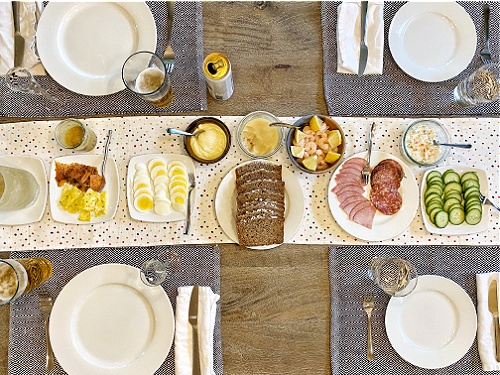I’m particularly proud of this recipe. I developed it when we ran out of IKEA rye bread mix and couldn’t find a recipe that (1) had ingredients that were easily obtained and (2) was extremely tasty. This is also an easy recipe. Don’t be deterred by some of the ingredients. This is very much a mix-it-and-let-it-be-type bread.
Henning is Danish and introduced me to all sorts of different food over the past 18 years. I have my favorites–frikadeller (Danish meatballs), hakkebøf (a hamburger steak-type dish), smørrebrød (open-faced sandwiches). All of these dishes invoke hyyge, which has become a buzzword, but is the feeling of comfort and coziness, just being.
This rye bread (rugbrød) is perfect for open-faced sandwiches. These types of sandwiches are delicious and layered with favor. The bread gets a smear of butter or bacon fat (at Christmas Henning mixes bacon fat and duck fat) and prepared with toppings from the fish, meat, or cheese course. Depending on the occasion, what we call “Danish Lunch” might last for hours. We sit around the table with all the smørrebrød fixings, beer, and snaps. In the beforetimes, we would invite friends over and enjoy hours of good food and conversation.


Danish Rye Bread (Rugbrød)
Equipment
- spice grinder, stand mixer, food scale, Pullman loaf pan (or long loaf pan [16×5] or two bread loaf pans)
Ingredients
- 3 cups warm water*
- 3 tsp yeast (I've made this instant yeast and active dry yeast–there isn't a huge difference because of the type of yeast for this recipe.)
- 700 grams whole-grain rye flour
- 150 grams bread flour
- 15 grams kosher salt
- ¼ cup molasses
- 1 cup buttermilk
- 1 cup sunflower seeds
- ½ cup flax seed
- 1 cup cracked rye berries** (Crack rye berries in a spice grinder or use a mortar and pestle)
- ½ cup whole rye berries
- ½ cup traditional rolled oats (For sprinkling on loaf before baking)
Instructions
Make the dough
- Please check out the recipe notes below before diving in!
- In the bowl of a stand mixer with a paddle attachment, add the yeast and warm water. Let stand for at least 5 minutes.
- While the yeast blooms, prepare dry ingredients. In a large bowl, whisk flours and salt together. In a medium-sized bowl, mix together seeds with a wooden spoon.
- Add molasses to yeast mixture. Mix on low.
- Slowly add flours. This is a wet dough, so don't worry if it doesn't pull away from the sides of the bowl.
- Once the flours are added, slowly mix in the seeds.
- Transfer dough to a large, nonreactive bowl. (I used a large ceramic bowl, but glass or stainless steel works as well.)
Let the dough rest
- Cover the bowl with plastic wrap and place in a warm, dry area. I usually just let the bowl sit on the counter, under our under cabinet lighting. Let it rest for 12 hours–I've let it sit for 14 to 16 hours and it's just gotten a little more sour. You want to signature sour flavor. It will bubble and rise a little. It should smell yeasty, sour, and a little earthy.
Bake the bread
- Grease loaf pan with butter. (I use a loaf pan that's 16×5, but a Pullman loaf or two loaf pans would work.)
- Transfer dough to the loaf pan. Smooth out dough and make sure it's settled in the pan. Sprinkle top of dough with water and sprinkle on rolled oats.
- Preheat oven to 375°F.
- Let dough rest in pan while over preheats.
- Cover pan with foil and bake for 45 minutes. Uncover and continue baking for about another 20 minutes. When done, the internal temperature should be 205°F.